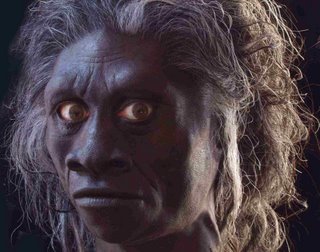
The Geology Society reports:
Palaeontologists rebut claims that the so-called "Hobbit" fossil from Flores, Indonesia, is a new species, amid recrimination over hype and poor science.
When scientists found 18,000-year-old bones of a small, humanlike creature on the Indonesian island of Flores in 2003, they concluded that the bones represented a new species in the human family tree that they named Homo floresiensis. Their interpretation was widely accepted by the scientific community and reported in the popular press worldwide. Because of its very short stature, H. floresiensis was soon dubbed the "Hobbit...."
Increasingly, however, this controversial conclusion is being questioned. In a Technical Comment published topday (19 May 2006) in Science magazine, scientists led by Dr Robert D Martin, Provost of the Chicago Field Museum and world-renowned primatologist, say that the bones in question do not represent a new species at all. A far more likely explanation is that the bones belonged to a modern human who suffered from microcephaly, a pathological condition that causes small brain size, often associated with short stature.
There follows a long exposition of the problems associated with the fossil and the way in which it has been presented and analyzed.
The concluding paragraph is particularly damning.
"There has been … too little critical scientific evaluation surrounding this discovery and it is simply unacceptable that papers should be published without providing proper details of the specimens examined" Martin says. "The principle of replicability is fundamental to good science, and it has not been respected in this case."
Read the whole thing here.
UPDATE:
Carl Zimmer comments on Martin's charges and the response to them here.
For links to both sides of the controversy go here.
And John Hawks comments here.
No comments:
Post a Comment